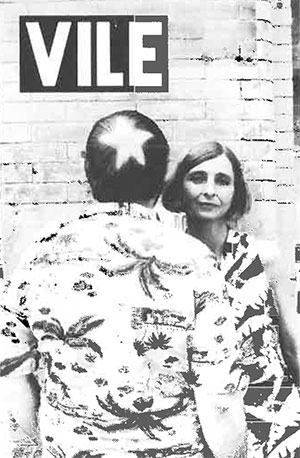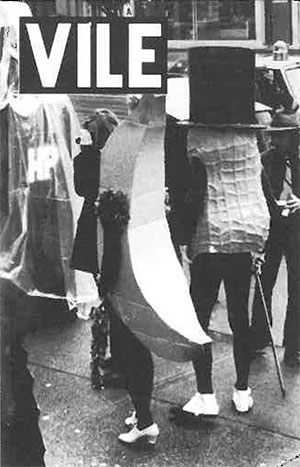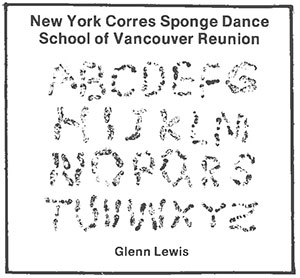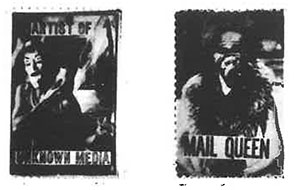Anna Banana: Mail Art Canada & Western U.S.A
Banana, Anna: Mail Art Canada & Western U.S.A, in: Mail Art Then and Now, The Flue, Vol. 4, No. 3-4 (special issue), 1984 Winter, pp. 25-28.
Before settling down to discuss mail-art's early stirrings on the West Coast and in Canada, I think it only fair to acknowledge Ray Johnson, whose wit, genius and imagination got the whole thing rolling. Got it going, at least, as a recognizable movement, a phenomena. No doubt artists and other creative individuals have always included drawings, collages, photos in their letters to friends and families. I certainly did, and have heard the same from many other artists. And, many still do, without ever entering into exchanges with the "International Mail-Art Network," that has grown out of Johnson's New York Correspondence School.
The first link between Johnson and the West Coast art community was in 1968, when Michael Morris, AKA Marcel Dot/Marcel Idea, from Vancouver, visited NYC. Morris, along with Vincent Trasov (Mr. Peanut) and Gary Lee Nova (Art Rat) were collaborating at the time on Image Bank; their project to collect, classify and archive images from the commercial media. Morris was instrumental in bringing Johnson and his collages to Vancouver in March of '69, as one of the artists exhibiting in the Concrete Poetry show at UBC's Fine Arts Gallery.
At this time, address lists were exchanged, and in 1970 Morris, Trasov and Lee Nova began issuing one or two page "Image Request Lists," which gave name, address and a brief listing of the sorts of imagery each artist would like to receive. For example, Peter Daglish wants palm trees and drag queens; Lee Nova wants telephones and sunglasses, Flakey Rose Hips wants recipes, etc.

VILE COVER SERIES: HOMMAGE TO DUCHAMP
BY ANNA BANANA AND BUSTER CLEVELAND.
Toronto and New York. August 1978.
In the meantime, American artist Dana Atchley began teaching at the University in Victoria on beautiful, but isolated, Vancouver Island. Cut off from friends and any stimulating art community, he decided to do a project to keep up his contacts with the "outside world." Inspired by Ian Baxter's N.E. Thing Co., which he liked because it created "a good interface with the real world," and gave the artist the anonymity of a corporate identity, Atchley registered himself as A Space Company with the provincial government. Then he bought 250 3-ring binders and sent out invitations to all his friends to participate in a self-publishing project, the Notebook. Those invited were to extend the invitation to their friends, and to send 250 copies of up to 10 pages. No work would be rejected, as long as the contributor sent the required 250 pages. By the end of the year (69), there were about 60 contributors, and Atchley set to work, with the help of Eric Metcalfe (Dr. Brute) and Kate Craig, to assemble the 1st edition.
Meanwhile, back in Vancouver, Morris, further inspired in his own mail projects by the response to the Notebook project, began working with Trasov and Lee Nova on a massive postcard show. They pooled address lists, including Ray Johnson's and Atchley's. The First Image Bank Postcard Show, curated by Alvin Balkind, was exhibited in October 1971 at UBC's Find Arts Gallery. It then travelled Canada, showing in another 8 or 9 galleries and made its final public appearance in Paris in 1973 as part of the Trajectoire '73 Show. Coach House Press in Toronto published an edited set of postcards from the show in 1972, the boxed edition quickly becoming a collector's item.
In 1970 another Vancouver artist, Ed Varney (Mr. Poem) began his mail-art activities under the banner, The Poem Company. His mailings were a small booklet of poems printed on an 8½ × 11" sheet, folded twice and cut to form an 8 pg. booklet. These were sent to about 300 people, friends, artists and poets with whom he was acquainted, asking for a poem or some other response.
In ‘70-71, Atchley launched his second notebook project, A Space Atlas, with invitations going to the increasing numbers of contacts that came about from the meeting of Atchley, Morris and Lee Nova. This second notebook drew over 120 participants from 7 countries, and in the fall of 71, Atchley, with the aid of a Canada Council grant, left Victoria with his van full of Space Atlas, to personally deliver them to the North American contributors. This started him off on a ten-year stint as visiting artist, presenting his Road Show to university art departments from Vancouver to Athens, Georgia, and ended his involvement with mail-art.

VILE COVER SERIES: ANNA BANANA, MR. PEANUT,
AND HANK BULL AT THE ART RACE.
Vancouver Art Gallery. May 1974.
1971 was a year in which the simultaneous beginnings of many artist publications had the unexpected effect of illuminating a "network." This flurry of publishing made the many isolated individuals and small groups aware of themselves as members of a much larger group, which was soon referred to as the "International Mail-Art Network." These publications stimulated intensified mailing activities by all concerned, and the next two years saw a dramatic increase in the number of people involved and quantity of work being mailed. Aesthetics dropped (more quick-print & xerox "mailers" vs. original drawings and collages) as quantity grew, and by 74 many of the original mailers quit the network in favor of private practise with selected favorites.
In the Bay Area, Patricia Tavenner (Mail Queen), feeling a need for more dialogue and creative input, began organizing her collaborative publishing project, Mail Order Art. Her idea was to produce a newsprint tabloid of artwork that provoked interchange. Collaborators were to contribute work, help pay the printing in exchange for a portion of the run which they could distribute to their friends and contacts. Her collaborators in the first issue of Mail-Order Art were Lew Carson, Phillis Ideal, Peter Hagburg and Nancy Maas Mosen (Irene Dogmatic).
A copy of the first issue found its way to Ray Johnson who responded with an invitation to participate in a show organized in Chicago. Tavenner sent work, and in time got a catalogue listing the names and addresses of all participants, and her network expanded accordingly. There were 4 issues of Mail Order Art from 1971 through 1973, each with a new set of collaborators. During that period, Tavenner produced her first artist postage stamps; 12 editions of 30 copies each, offset and perforated. She also began her years of work with Dogmatic on collaborative performances and postcards.
In Victoria, I began publishing the Banana Rag, a 2 to 4 page newsletter, as a supplement to my Town Fool activities. The first few issues, published bimonthly, were mailed to friends, Lee Nova amongst them. He put me in touch with the developing network by sending copies of the Image Request Lists that he and Morris had been producing. Intrigued, I sent out images as requested, included a copy of the Banana Rag and asked for banana information, images, etc. The response was immediate and positive, and I soon found myself mailing to Dr. Brute, Flakey Rose Hips, Marcel Dot, Ray Johnson, Davi Det Hompson, Richard C., Stu Horn, Dadaland, Irene Dogmatic, Pat Tavenner, Ms. Generality, Mr. Poem, Ken Friedman, etc., etc.
In Calgary that year, Don Mabie (Chuck Steak) began his mail-art activity by printing up 500 copies of his drawing, sending it to friends and people in the media. Also in Calgary, Clive Robertson, newly arrived from England, began using the mails to break down the distance between himself and various artist friends in England and Europe. He focused on bringing in scripts and ideas for performance works he could realize in Calgary, rather than images. He, like the rest of us, had no idea there was a "network" out there.
In the fall of '71, the first issue of FILE magazine appeared, illuminating the overall picture of mail-art activity to date and giving the names, addresses and image requests of artists involved. FILE magazine, with its LIFE-like logo and page format was printed on newsprint with a glossy cover in editions of 3-5,000. It circulated widely, and it's two '72 editions included artists from Canada, the USA, all over Europe, South America and Australia. The magazine, edited and produced by General Idea, a Toronto based collective of artists including Jorge Zontal, Michael Timms (A.A. Bronson), Ron Gabe (Felix Parts), Mimi Paige and Grenada Gazelle, received financial support from the Canada Council.
In December 1972, Image Bank published their International Image Exchange Directory, a forerunner of Politi's Art Diary, listing over 300 artists, their image requests, addresses, etc., who had corresponded with them or appeared in FILE magazine's 1st three issues.
Two other items helped "popularize" mailart; an article about it by Thomas Albright, published in the Rolling Stone in 1972, and one by David Zack, "An Authentic Discourse on the Phenomena of Mail Art," published in Art in America in their Jan/Feb '73 issue.
These projects and publicity deluged the mail-boxes of these artist-publishers with more mail than they could answer. The mail-exchanges, which began between a select few suddenly turned into a flood of mail from a mass audience. Many of those initially involved, dropped out. FILE magazine shifted its focus to other facets of the contemporary art scene, refusing to answer mailart requests.
Back in California, in 1971 or 1972, Ken Friedman started sending out his Weekly Breeder, one or two 8½ × 11" collaged "flyers" from his San Diego base. I would guess this activity grew out of his earlier association with the Fluxus movement in NYC, and expect it was through that connection that he appeared on the Image Request Lists. Out of Los Angeles, I received mailings from the Bon Bans, Gerry Dreva, Bobby Lambert and others mailing newsclippings of their appearances/performances. Lowell Darling was also mailing works from L.A., original, handdrawn postcards and notices about his projects to naildown certain cities, the San Andreas Fault, etc.
In 1972, Friedman passed the editorship of the Weekly Breeder on to the Bay Area Dadaists (B.A.D.), Bill Gaglione, Tim Mancusi and Charles Chickadel, who expanded it to book form producing 7 issues between '72 and the final issue in '74. These artists were also known as Trinity Press, after a small printing press they bought and ended up moving more times than they printed on it. Chickadel started up the West Bay Dadaist, a small instant-print publication in the 8½ × 11", folded twice format. Gaglione and Mancusi contributed to this publication as well, and it also appeared under the title Quoz? Monty Cazazza collaborated with the Bay Area Dadaists, and put out his own mailings, such as the Yellow Peril, as well.
Irene Dogmatic also went on to publish various instant-print booklets, such as her Dogarythims, Star Spanialed Boners, the Ganus Book of Dog Records, etc., for all of which she drew stories and material from the network. However, I'm getting a little ahead of myself here.
What has been called the "grand finale" of all his collaboration and cross fertilization by the initiators of the "first wave" of mail art, was the Decca Dance. This event, which took place in Hollywood in February '74, involved artists from Vancouver, Toronto, New York, San Francisco, Los Angeles and San Diego. A spoof on the academy awards presentations, it was inspired by and to a large extent organized through mailed communications. It was documented by video tape produced by Ant Farm, and later a book published at Coach House Press in Toronto.
After this, mail-art continued, but with a different set of principals, and principles. For the first wave, I would say that aesthetic communication with selected artists was the objective. For the second wave, I feel play, participation, and communication with a wide range of persons were the amended objectives.
Of the second wave principals, Chuck Steak of Calgary holds my nomination for the title KING of Mail-Art, for his dogged consistency in organizing, showing and documenting mail-art. From '73 to '81, Chuck organized a record number of mail-art shows, often with "boredom" as their theme... '73 - Homage to Boredom, '74 - 1st Annual Toronto Correspondence & Junk Mail-Art Exhibition, 2nd Homage to Boredom, etc. etc. In '75, he began publishing Images and Information, a mail-art magazine in the ½ × 14" folded format, with assistance of a government work initiatives program. His shows continued through '75 with the 2nd Annual Correspondence & Junk-Mail Art Exhibition, the 1st Calgary show of the same title, exhibiting these in Canada's parallel gallery system. (Many suggest this gallery system grew out of mail-art activity contacts). In 1976 Chuck organized 3 mail-art shows, finally abandoning the boring theme that had by then bored me to absence. In 1977 he organized two shows, one at the New Reform Gallery in Aalst, Belgium, the second in Calgary at Parachute Center.
1978 saw him busy with changes within the gallery as Parachute metamorphosized into Clouds 'n Water Gallery, where he organized 6 shows in 1979. 1980 was a quiet year, then 1981 brought about his involvement with Rough Cut Audio Art and his last big (to my knowledge) mail-art show, IMAGINE / The Legacy of John Lennon which showed at Off Center Center, then toured.
In Vancouver, the second carry-over from the first wave, Ed Varney quietly continued his publishing and mailing activities. After his '71 issues of The Poem Company, he produced a couple of editions called Junk Mail; the first a printed envelope of materials from the press, the second, a box of postcards. In 1973, he produced an edition of 500 copies of Stu Horn's book, The NorthWest Mounted Valise. After numerous postcards, rubber stamp and stencil works, he began publishing artist postage stamps.
His 1st International Artist Stamp Edition, 1 sheet, 2 colors, perforated, appeared in 1976, and the 2nd edition, again in 2 colors, appeared in 1978. In 1980, he organized a mail-art show, Global Postal, the catalogue for which took the form of 5 or 6 sheets of artist stamps, printed in black only, and perforated. His most recent edition, his 3rd International Artist's Stamps, is 4 sheets of full color stamps. In every instance, contributors received a free copy of the edition, and persons wishing to purchase these should contact Ed through his Museo lnternacionale de Neu Art (MINA), Box 3655, Vancouver, BC, Canada V6B 348.
And last, but not least, we have yours truly as the third carry-over from the 1st to 2nd wave of mail-art. By the time of the 2nd wave, I was living and working in San Francisco, having made the move from Vancouver in the summer of '73. I produced my 9th and 10th edition of the Banana Rag in San Francisco that year, the 10th being a set of 12 postcards, instant printed at my first SF job.
By then the editors of FILE were chafing at all the "quikkopy crap" junk-mail they were receiving, and published several letters to that effect in their fall 1973 issue. Still hot on mail-art myself, and surrounded in my new job with the means of quick, cheap production, I decided to take up the cause of mail-art myself. And thus, VILE was born. I solicited contributions from my correspondents and in February '74 produced my first issue, 56 pages, in an edition of 200. These were instant printed, with vello-binding and a glossy, two-color wrap-around cover. A 48 page second edition came out that fall, 200 copies.
Neither of these editions satisfied my desire to parody LIFE, so the third issue, published in '75, included poetry and fiction laid-out with old ad art from early LIFE, and came much closer to my idea. The CCLM (Coordinating Council of Literary Magazines) approved my grant application, and put $500 into the production, which was produced in an edition of 1,000 copies, saddle-stitched.
Gaglione, with whom I'd lived since moving to SF, decided to get into the act too, publishing the 4th issue of VILE (numbered 2/3), the double international Issue in an edition of 1,000, perfect bound. The major difference in our approach was my interest in parodying LIFE, and to that end, publishing poetry and fiction for the "textural quality." A certain part of me also wanted to maintain the "vile" theme of the publication, which Bill, in spite of his dada sympathies, did not share.
The Summer of ‘77 issue of VILE, my fourth production, finally achieved the overall appearance I had been after from the beginning. While I had always reproduced mail-art works as received, this issue combined these works with texts, photos and ad art in such a mix that I felt the uninitiated reader MIGHT confuse it with LIFE on first inspection. Having accomplished that, and having seen FILE do battle and lose to TIME/ LIFE over their use of the LIFE-like logo, we decided it was time to move on to other cover designs.
In '78, Bill produced VILE 6 in a new format (7 × 10"), with a totally different cover and subject focus than all previous issues. For Fe-Mail-Art, as the 6th issue was subtitled, we gleaned material from our archives. I wrote the introduction and managed to get another grant from the CCLM. Their $923 paid for an edition of 675 copies of what proved to be one of the most popular issues ... all about women involved in mail art.
The 7th issue of VILE, called STAMP ART, is a special, limited edition of 300 copies of hand-stamped pages by 200 artists in the International Network. It was edited by Gaglione, and was in the works for the better part of two years. A third CCLM grant assisted in the production and mailing of this edition, which first went out in the fall of '80. The first 200 went to contributors, the 3rd hundred sold out within a year. Since then Gaglione has continued his interest in rubber-stamp works, and has produced 4 editions called STAMP ART, in which participants send 150-200 copies of their page. Gaglione binds and distributes them. Back issues are available from him at Abracadada, 2311 Lake Street, San Francisco, CA 94121.
Since my return to Vancouver in January of '81, I've attempted to cut back on my mail-art activities, but without much success. I've produced issues 16 and 17 of the Banana Rag since my return, primarily to answer the growing number of children involved in mailart. (These are inspired by Randy Harelson's book, S.W.A.K. - Sealed with a Kiss, and I feel there must be some way of getting children involved in mailing without necessarily connecting them with adults. One or two aren't bad, but I've been swamped!)
After struggling with it since the summer of '79, I have finally managed to publish my final edition of VILE, done as a book, About VILE. In this edition I pay long overdue tributes (Excerpts: Tour Journal) to our European mail-art friends who we visited in the course of our '78 tour. It's a book in the same format as the magazine, giving its own history, biographies of a number of my "heros" in the network, and an excellent article about mail-art by Michael Scott in Leeds, England. There's an 8-page feature on the work of Robert and Ruth Rehfeldt of East Berlin, and a portfolio of photos from events I organized over the years, but omitted from VILE because they weren't (vile). This book is my swan song to mail-art, although it appears more and more unlikely that I shall ever completely disentangle myself from this fascinating activity.
Before closing this already over-long account, I must mention a few artists whose contributions have been substantial, if not as sustained as those discussed at greater length. In Vancouver, Rick Hambleton (Trace-It) published two editions of I. D.'s Mr. Reee Search in '79, with works from 300 participants in 29 countries. There was also the mysterious Five / Cinq Aesthetics who produced an edition of 500 "legally genuine" share certificates in the "Radiant Energy" of Five / Cinq Aesthetics in Dec. ‘78. They dissolved the company in 1980 after producing a "Not Responsible" series. Another Vancouver artist, Ladislaw Guderna produced three of Scarabeus (6 × 7½ format) in ‘79 and ‘80, distributing these to the network. He's also produced numerous postcards and postage stamps.
In Seattle there's Raymond Chew, whose high quality printed and color xeroxed postage stamps circulate on a limited scale within the network. He sends his works to people whose work he likes, and ignores the rest. Another west-coaster I can't quit without mentioning, is Buster Cleveland. While he hasn't done any publishing, he has produced limited edition color xerox prints of his many outstanding collages, and these are treasured items in the collections of many. Buster lived in Ukiah and, along with Polly Ester Nation and Nicola Vanzetti, led the organization of the Inter-Dada 80 Festival in May of that year. Inter-Dada '80 was, like the Decca Dance years earlier, a 4-day festival of contemporary arts, based on the mailart network, and drawing participants from New York, Gurdon Ark., and Italy, as well as all parts of California.
A publication that has done much to substantiate Mail-Art, since its inception in '78, is Judith Hoffberg's UMBRELLA, with its reviews of artist books, mailart shows and listings of mail-art shows, deadlines and themes. Anyone wishing to get into mail-art should send $3 to Umbrella for a sample copy. The address is PO Box 40100, Pasadena, CA 91 104.
That about winds it up. There are many many artists with whom I've exchanged works, and whose works I keep safely in my archive, but who've not been mentioned here. I regret this, but given the space limitations for this article, I've had to draw the line somewhere. My apologies.

CHUCK STAKE. ENVELOPE. 1982. Ronny Cohen Collection. Imagery related to IMAGINE: THE LEGACY OF JOHN LENNON, a mail art exhibition by Chuck Stake and held at Roleson Square Media Center, Vancouver. July 14-21, 1981.

GLENN LEWIS. NEW YORK CORRES SPONGE DANCE SCHOOL OF VANCOUVER REUNION. 1970. Photo source: ART AND CORRESPONDANCE FROM THE WESTERN FRONT. Western Front Publications. 1979.

IMAGE BANK POSTCARD SHOW. 1971. Photo source: ART AND CORRESPONDANCE FROM THE WESTERN FRONT. Western Front Publications. 1979.

PAT TAVENNER ARTIST OF UNKNOWN MEDIA and MAIL QUEEN. 1973. Photo source: ARTISTS' STAMPS AND STAMP IMAGES. The Simon Frasier Gallery, Simon Frasier University, Burnaby, British Columbia, Canada, 1976.
